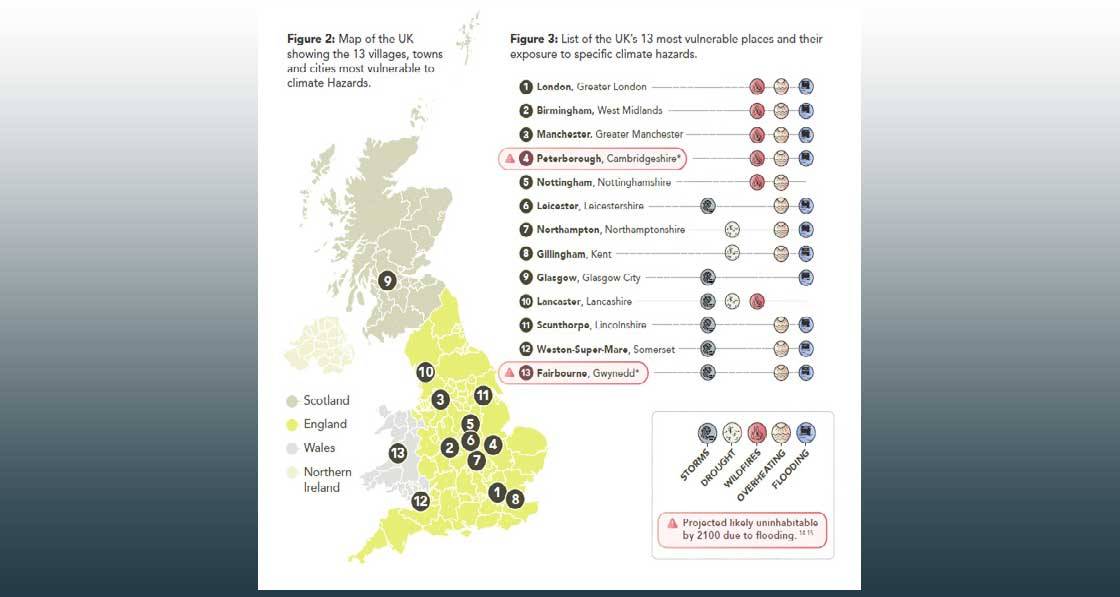
- Climate Change
- Posted
Climate report warns overheating crisis threatens UK
This article was originally published in issue 50 of Passive House Plus magazine. Want immediate access to all back issues and exclusive extra content? Click here to subscribe for as little as €15, or click here to receive the next issue free of charge
The research, the UK Climate Resilience Roadmap, warns that climate change threatens to make parts of Britain uninhabitable within decades, with the cathedral city of Peterborough and Welsh village of Fairbourne facing potential abandonment due to flooding by 2100.
The roadmap, developed by the UK Green Building Council alongside major industry partners including Lloyds Banking Group, Mace, Arup and Zurich, identifies thirteen areas across Britain most vulnerable to extreme weather hazards. The comprehensive two-year study reveals that schools in London and the South East could face heatwave temperatures for 10 weeks annually under a relatively modest 2C warming scenario.
The report's stark findings were published as parts of the UK faced their second heatwave this summer, underlining the immediacy of climate risks. Six million homes in London and the South East will endure temperatures exceeding 28C for two weeks each year, whilst care homes in these regions face four weeks of such extreme heat annually.
Beyond overheating, the roadmap details how Britain's homes, schools, hospitals, offices and infrastructure face mounting threats from five interconnected climate hazards: overheating, flooding, drought, wildfires and storms.
The most vulnerable locations span England, Wales and Scotland, including major urban centres such as London, Birmingham, Manchester, Glasgow, and smaller communities like Scunthorpe and Weston-super-Mare. Hull, Portsmouth and parts of London could be underwater by 2100, with sea level rises of up to 1.12 metres projected under high-emissions scenarios. Wildfire risks present another emerging threat, with extreme fire danger days potentially increasing five-fold from approximately twenty to over one hundred annually by 2080.
Simon McWhirter, chief executive of the UK Green Building Council, emphasised the urgency of action: "The UK Climate Resilience Roadmap starkly illustrates the threats of a changing climate, not in the future, but right here, right now. Our homes, schools, hospitals, parks and offices are on the front line, and they are in danger."
The report presents eight key policy recommendations, including establishing an office for resilience within the cabinet office, restoring the minister for resilience role, and ensuring all planning decisions deliver climate safety. It also calls for protecting communities with trees, parks and ponds whilst creating a new generation of green professionals.
Current global policies place the world on track for 2.7°C of warming by 2100, according to the Climate Action Tracker, significantly exceeding the Paris Agreement's targets. The roadmap argues that with such warming trajectories, immediate adaptation measures are essential alongside continued emissions reduction efforts.
The study involved extensive modelling using standard industry methods published by the Chartered Institution of Building Services Engineers, drawing on open-source government data to assess physical risks, access to green spaces, and social vulnerability across the UK
Related items
-
 King of the castle
King of the castle -
Retrofit redux: Catching up with A3
-
 Energy poverty and electric heating
Energy poverty and electric heating -
 September’s AECB environmental construction conference seeks to spark debate among industry experts
September’s AECB environmental construction conference seeks to spark debate among industry experts -
 Ecological Building Systems expands UK and Irish straw panel construction with EcoCocon deal
Ecological Building Systems expands UK and Irish straw panel construction with EcoCocon deal -
 Focus on better buildings, not better spreadsheets
Focus on better buildings, not better spreadsheets

